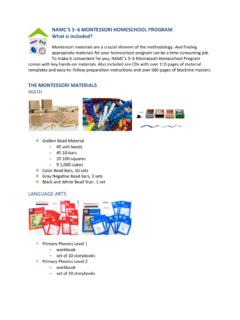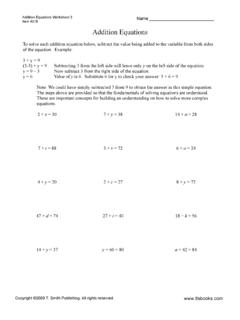Transcription of When a Child Doesn’t Remember What He Reads!
1 The Family CURRENT. Published by Family Learning Organization Mead WA. V. 27 No 3 September 2013. When a Child doesn 't Remember what He Reads! By Dianne Craft, MA, CNHP. One of the most puzzling situations a homeschooling mother finds herself in is when she has a Child who can read the words in a book but cannot answer the questions or tell her what has just been read. These moms frequently hear the phrase I don't Remember when queried about the reading material. When working with bright, hardworking fourth- through eighth-graders in my reading class, I often had students who were experiencing this particular read- ing difficulty. I realized that these students were not proficient at converting the words they were reading into a movie in their head, as the rest of us do when we read. They were merely doing word calling much of the time. I found that movie making was a skill that could be developed in them, using an easy fif- teen-minute-a-day exercise.
2 This exercise did not involve paper or pencil but only the use of the brain. Word calling is a left-brain auditory task, while creating a picture or movie of those words is the responsibility of the right-brain hemisphere. I merely showed them how to create a seamless flow of words to pictures as they were reading. You can do this at home, very easily. Converting Words to Pictures When a Child or teenager regularly reads a passage well but can't Remember what is said, we know that he is using an inefficient strategy for comprehen- sion. He often is trying to Remember the exact words he read, rather than con- verting the words into pictures. Whether he is reading for recreation or informa- tion, he must change the words he reads into images in his mind. The more these images involve the senses (sight, sound, smell, feel), the greater will be the comprehension of the passage. Daily Training Sessions The following steps can be used with a student to develop his ability to change the words he hears or reads into pictures for good comprehension.
3 You will be surprised how fast his comprehension skills will improve after just a few weeks of these training sessions. This method works well with one Child or a group of children or teenagers. Step 1: Parent/Teacher Reads a Passage Aloud Choose material to read to the Child that is interesting and very descriptive. Standing in front of him as you read to him, have the Child sit upright and keep his eyes up- ward, creating a movie in his mind. You can pretend that you are looking at the projection screen in a movie theatre to further aid him in his movie making. Read a sentence or two aloud. Then ask him a few questions until you are sure he is seeing the pictures of the words you read, in detail. For example, this is how your training session might look if you are reading aloud a passage about a beaver. Your first sentence you read may be, The beaver is the largest rodent in North America. Stop reading, and point to the imaginary screen, and say, On our screen, let's draw a quick sketch of North America.
4 Now put the beaver on that map.. Your next sentence in this passage will read, An adult beaver weighs from 35 70. pounds. Stop reading and point up to the imaginary screen and say, Now, use the zoom lens' of your brain camera and write 35 70' on the beaver's coat. Let's use white paint to do this. Is your paint dripping? Oh well, he'll wash it off soon.. The next sentence in the text will be, Because of its large lungs, a beaver can remain submerged in water for fifteen minutes. Stop reading and look up at the screen and help the Child see this in his head by saying, Now we need to change our scene. Let's make a picture of a pond, with beavers around it. Do you see it on your screen? Now have one of the beavers slip into the pond. See him down on the bottom of the pond. Picture a large clock next to him. Have the hands of the clock move from 12:00 to 12:15.. As you do this training, instruct your Child how to move his pictures and freeze . them when he wants to notice something.
5 You both will have great fun with this! When you get to the end of a passage you're reading, instruct your Child to rewind . the movie, to answer some questions about the passage. As you ask the questions, direct his gaze upward as he reviews his movie for the answers. This is the exciting part. Your Child will be amazed at how easy it is to answer the questions. Step 2: The Student Reads Aloud to You After your Child has demonstrated proficiency in converting words to pictures as he hears them, he is ready to read the words himself while creating his movie. Select a reading passage that is easy for him to read so that he can concen- trate on making pictures rather than sounding out new words. Repeat the process you used before, stopping him after he has read a sentence or two, to ask him some questions about his movie. Direct his gaze upward to see what he just read. Be sure he gives you detailed pictures. As this becomes easier and his recall becomes more accurate, you can increase the number of sentences he reads before you ask ques- tions.
6 2. Step 3: The Student Reads Silently When your Child is successfully reading aloud while making good pictures in his mind, you can have him read a passage silently, asking him to stop every few lines or so, and asking him to tell you about the pictures he has made. If the pictures are detailed and accurate, you can have him read to the end of the passage uninter- rupted. At the end of the reading, have him rewind his film and tell you all that he has read. You will be surprised at the things he remembers! His words to pictures . process will soon become automatic. The upward eye movement will soon be un- necessary for the storage and retrieval of reading material. Remember : No pictures=No answers; Few pictures=Few answers; Great pic- tures=Great Answers. This strategy is simple, but very effective. Expect to see great changes in the com- prehension and retention of reading material in your children. Dianne Craft has a master's degree in learning disabilities.
7 She speaks widely at homeschool conventions across the country. Her books, Brain Integration Therapy Manual, Right Brain Phonics Program, and her DVDs, Understanding & Helping the Struggling Learner, Teaching the Right Brain Child , Smart Kids Who Hate to Write, and The Biology of Behavior have helped hundreds of families remove learning blocks in their struggling children at home. Visit her website, , for many articles on children and learning and to download her free Daily Lesson Plans for the Struggling Reader and Writer. Copyright 2012, used with permission. All rights reserved by author. Originally appeared in the March 2012 issue of The Old Schoolhouse Magazine, the family education magazine. Read the magazine free at or read it on the go and download the free apps at to read the magazine on your mobile devices. I learned most, not from those who taught me but from those who talked with me. -St. Augustine 3. Here are five general points from the researchers on increasing learn- ing through environment and relationship.
8 Read the list and consider how your home is the best place for this to happen: Create an environment where it is safe to explore and make mis- takes, with a positive expectation of success (as opposed to an an- ticipation of failure). Emphasize the relevance of what is being studied, answering, How is this important to my life? . Provide an emotionally positive experience for students by being with others, utilizing laughter, taking regular breaks, and giving wholehearted encouragement. Involve the five senses touch, taste, sight, hearing, smell as of- ten as possible in what is being studied; consider the big picture, . asking, what does this really mean? and How does it affect the world? (as opposed to mere memorization). Teach it to someone else, since this requires real understanding rather than a mere acquaintance with a subject. Any teacher who implements these five principles will immediately open the door for students to actively involve themselves in the proc- ess of learning a key to self-motivation.
9 And, significantly, students will have the opportunity to actually enjoy the experience. PERIODICAL LIST. The Old Schoolhouse Magazine Phone: 888-718-home Home Education Magazine Home School Enrichment A Christian Based Resource 800-558-9523. Teaching Home phone: 503-253-9633. 4. FLO TESTING SERVICE. Standardized Tests California Achievement (CAT) K-12 $ CAT Survey (CS) 2-12 $ Markable CAT (MC) K-3 $ Basic Achievement Skills Inv (BASI) 3-12 $ TerraNova (T) Grades 1-12 $ Practice Tests (PT) 1-3 $ S&H for Test Orders (Cont US) $ Test Prep Spectrum Test Prep (STP) 1 8 $ Test Prep grade 9 or 10 (TP9 or TP10) $ GED Prep $ S&H (if ordered without test) $ Assessments*. Checklist (CSL) K-12 $ Freestyle (FAF) $ (No S&H charge on these items). *These reports are completed by parents and evaluated by a Washington State certified teacher to document the Child 's academic progress according to state standards. If you are unsure of the homeschooling laws in your state, go to or for specific State information.
10 There are two special gifts we should give our children. One is roots, the other is wings.. -Unknown 5. KID'S PAGE. Leaf Alphabet A fun fall craft idea to transition from summer break to school. For directions and other great fall ideas, go to Martha Stewart's Crafts for Kids online. 6. BOOKS. Academic Homeschooling: How to Give Your Child an Amazing Education at Home - Tracy Chatters Suddenly Homeschooling: A Quick Start Guide to Legally Homeschool in 2 Weeks - Marie-Claire Moreau, Learning Styles: A Guide for Teachers and Parents - Barbara K Given A Child 's Garden: Enchanting Outdoor Spaces for Children and Parents - Molly Dannenmaier ONLINE RESOURCES. - free downloadable lessons - economically-priced curriculum - free lessons and craft projects - books & CDs to purchase - math worksheets & science projects - educational games - articles about homeschooling - state laws and support groups - free lessons and membership for a fee - free lessons - Algebra work sheets Lesson Plans Inc.





